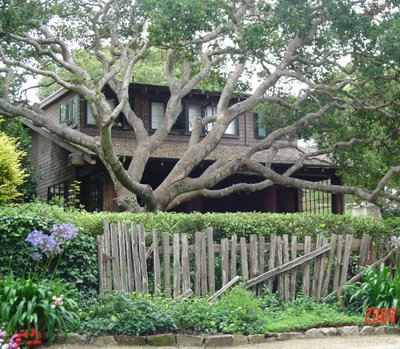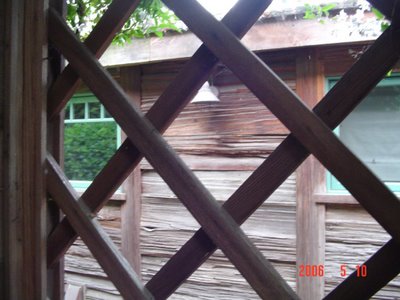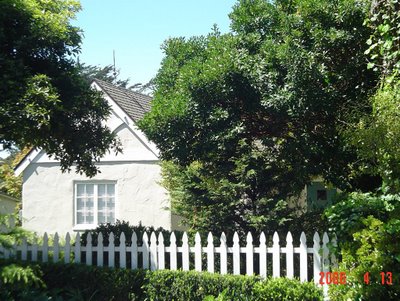CITY OF CARMEL-BY-THE-SEA
STAFF REPORT
TO: MAYOR McCLOUD AND COUNCIL MEMBERS
FROM: RICH GUILLEN, CITY ADMINISTRATOR
DATE: JULY 3, 2006
SUBJECT: CONSIDERATION OF A RESOLUTION GRANTING CONSENT
TO THE CITY OF MONTEREY TO FORM THE MONTEREY
COUNTY TOURISM IMPROVEMENT DISTRICT
City Administrator Rich Guillen's STAFF REPORT, as noted above, contained verbatim plariarized content from the Monterey County Convention & Visitors Bureau's (MCCVB)"Increasing Tourism & Occupancy in Monterey County with a Tourism Improvement District" report.
As follows, the locations of Guillen’s plagiarized MCCVB content as the information appeared in his STAFF REPORT, the locations as the information appeared in the MCCVB’s PR report and the content:
Guillen’s paragraph 1 is verbatim MCCBV’s “A Tourism Improvement District (TID) for Monterey County" paragraph 2:
The MCCVB, together with a coalition of lodging owners and general managers, proposes forming a TID in Monterey County to take effect January 2007. The proposed TID includes, preliminarily, all lodging establishments located within the unincorporated areas of Monterey County and the incorporated city limits of Carmel-by-the-Sea, Del Rey Oaks, Gonzales, Greenfield, King City, Marina, Monterey, Pacific Grove, Salinas, Sand City, Seaside, and Soledad.
(Note: Guillen eliminated Gonzales, Greenfield, King City, Pacific Grove and Soledad.)
Guillen’s paragraph 2 is verbatim “A Tourism Improvement District (TID) for Monterey County” paragraph 1:
Tourism Improvement Districts (TIDs) have been used successfully in destinations throughout the country to promote tourism, increase occupancy, enhance visitor services, and increase sales andcommercial activities. Competing California destinations such as Sonoma County, San Jose, and Sacramento are three of the many state locales with TIDs in operation; Napa County, San Diego, and San Luis Obispo, among numerous other communities, now have TIDs in development.
Guillen’s paragraph 3 is verbatim MCCVB’s “Tourism Summary” paragraph 1:
Tourism in Monterey County peaked in 1999 and dropped off significantly thereafter as the economy faltered. Since then, Monterey County has recovered at a much slower rate than the rest of California, with occupancy still 12.1% lower that it was in 1999.
Guillen’s paragraph 3 is verbatim MCCVB’s “Tourism Summary” paragraph 2:
A 23.8% increase in room revenue since 1999 has created a false sense of a healthy tourism industry in the county. The reality is that room revenue has increased largely because our room rates have risen 36.6% to become the highest in California.
Guillen’s “STAFF REVIEW” is verbatim “TID Mission & Vision” paragraph 1 & 2:
The mission of the TID is to provide the county and the MCCVB with a well-managed, stable funding source for tourism promotion, which will generate more revenue for lodgings and tourism-related businesses, and deliver a direct return on investment to municipalities in the form of increased transient occupancy tax (TOT) revenue for the general fund. A TID will allow the MCCVB to realize its vision for the county, a vision of regaining market share and becoming a top destination nationwide for individual travelers and groups. MCCVB projects that by driving occupancy back up to the 1999 level of 71.2%, the county will generate an additional $56.2 million in annual hotel revenues within five years.
. Guillen’s “TID Facts” is verbatim MCCVB’s “TID Facts:”
• The TID will be designed and governed by the assessed lodgings, and customized to fit the needs of our district
• Assessed businesses will automatically become members of the MCCVB, with no additional membership fee required to receive benefits
• TID funds cannot be diverted for other government programs
• TID funds will be used exclusively for tourism promotion
Guillen’s “Core Benefits of a TID” is verbatim MCCVB’s “Core Benefits of a TID”
• The many types of lodging establishments in Monterey County, from B&Bs to resorts, will unite in an unprecedented effort to promote tourism
• The TID will fund a greater number of innovative marketing initiatives by the MCCVB, proven to bring additional tourists to Monterey County
• An increase in overall tourists will bring more business to lodging establishments and tourism-related businesses countywide
• Participating municipalities will benefit from a greater TOT contribution to the general fund
Guillen’s “FISCAL IMPACT” is MCCVB’s “Funding the TID:”
The proposed TID requires an assessment of $1.00 per room night for full-service lodging establishments and $0.50 per room night for limited service lodging establishments (level of service as defined by Smith Travel Research). In addition, the MCCVB has developed an updated funding formula for municipality contributions based on TOT revenue. This unique matching of public contributions with private funding could result in an additional $2.2 million to be used exclusively for destination marketing.
Guillen’s “SUMMARY” is MCCVB’s “Conclusion” paragraphs 1& 2:
In 2004, visitors accounted for 53.8% of total tax receipts in Monterey County, the equivalent of $365 per household.
Monterey County will continue to be out-marketed by competing California communities unless we more aggressively promote the county as a destination. Forming a Tourism Improvement District will unite lodgings and municipalities, doubling the investment of each. A stable funding source will enable the MCCVB to conduct intensive marketing on behalf of Monterey County—[Guillen omitted the following: a destination with a rich history, distinctive attractions, and stunning natural beauty capable of drawing visitors from around the world.]
COMMENTS:
• City Administrator Rich Guillen’s attempt to claim the MCCVB’s PR material as his own, is not only plagiarism, it is deceitful; that is, it represents an attempt to fool Carmelites into thinking that his report is his own, instead of the PR materials of the MCCVB.
• A non-existent standard of professionalism is reflected in City Administrator Rich Guillen’s record; a record of prevarication, plagiarism and unprofessionalism.
• Needless to say, a professional City Administrator is an honest and independent arbiter of information, not a propaganda purveyor for a special interest, in this instance MCCVB. Unfortunately, the City of Carmel-by-the-Sea has the latter, not the former.
Reference:
Increasing Tourism & Occupancy in Monterey County with a Tourism Improvement District, monterey county convention & visitors bureau
In partnership with Monterey County and the Cities of Marina Monterey Sand City Seaside
http://www.ci.pg.ca.us/age/CCO/A-CCO20060517/9C.pdf, pages 5-6.

















